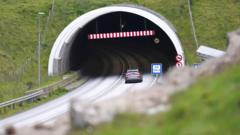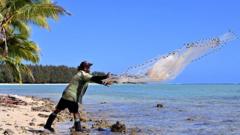The Shetland Isles are considering undersea tunnels to replace aging ferries, drawing inspiration from the successful infrastructure used in the Faroe Islands.
**Faroese Tunnel Inspiration for Shetland's Future Development**

**Faroese Tunnel Inspiration for Shetland's Future Development**
Shetland Islands Council seeks to revolutionize transportation by adopting Faroes-style tunnels, aiming for economic growth.
In a bold step towards enhancing connectivity and economic vitality, the Shetland Islands Council is exploring the possibility of constructing undersea tunnels to link four of its outlying isles, including Unst, which is recognized as the northernmost point in the UK. This initiative has garnered support from Aksel Johannesen, the Prime Minister of the Faroe Islands, who lauded the potential for growth and revitalization of island life through improved infrastructure, a model successfully adopted by his country.
With the Faroese attending to 23 tunnels—four of which are underwater—it’s evident that strategic investment in transportation can yield significant benefits. Johannesen highlighted that these improvements have stimulated both population growth and economic engagement in the Faroe Islands, which boasts a current population of roughly 54,000, contrasting with Shetland's 23,000 residents.
Critics argue that Scottish politicians have hesitated too long while places like the Faroe Islands have successfully executed such projects. Anne Anderson, representing Scottish Sea Farms, emphasizes the importance of expedited progress, calling for Scotland to "identify what works well for them and then just copy and paste," to combat the worrying decline in the global market share of Scottish salmon production.
Historically, the Faroe Islands have employed a "drill and blast" technique for tunnel construction since the 1960s, a process that offers a potential blueprint for Shetland's proposed infrastructure. Andy Sloan, a tunnel builder involved in the Faroese project, asserts that Shetland can replicate this success, emphasizing that a well-planned transport network could connect the islands and promote economic development.
Prof. Erika Anne Hayfield from the University of the Faroe Islands noted the social benefits of these tunnels, which enable residents of smaller settlements to participate fully in island life. However, she acknowledged that some community members have raised concerns about the financial implications and whether funds should be directed to other essential services like education and healthcare.
Shetland's current transportation infrastructure primarily relies on aging ferries, a system that involves significant costs and logistical challenges. Council leader Emma Macdonald affirmed that integrating tunnels could dramatically transform Shetland, overturning its perception as a remote locality and showcasing its potential as an advanced economy.
As discussions continue around the feasibility of the tunnels, the Shetland Islands Council has initiated a £990,000 feasibility study to assess the logistics of connecting Unst, Yell, Bressay, and Whalsay. Funding remains uncertain, but Johansen's model of utilizing tolls for repayment is gaining traction as a promising solution.
The necessity for modern transportation links in Shetland has been made all the more urgent by rising costs and service demands on the existing ferry network, which carries about 750,000 passengers annually. As calls for better infrastructure grow louder, there is a general consensus among Shetlanders that funding by toll may not be as unpopular as previously thought.
In light of varying opinions regarding the impact on island life, local shop owner Pat Burns reflected on the changes. Initially skeptical about the implications of tunnel construction, she has since recognized the practical benefits they could bring in terms of improved supplies and tourism potential. "If Unst doesn't get a tunnel, the challenge is going to be too big," she emphasized, underscoring the significance of progress for the community's resilience.
As Shetland takes steps towards a potential new era of transportation, the echoes of Faroese success resonate strongly, highlighting a path toward enhanced connection and economic stability for these remote islands.
With the Faroese attending to 23 tunnels—four of which are underwater—it’s evident that strategic investment in transportation can yield significant benefits. Johannesen highlighted that these improvements have stimulated both population growth and economic engagement in the Faroe Islands, which boasts a current population of roughly 54,000, contrasting with Shetland's 23,000 residents.
Critics argue that Scottish politicians have hesitated too long while places like the Faroe Islands have successfully executed such projects. Anne Anderson, representing Scottish Sea Farms, emphasizes the importance of expedited progress, calling for Scotland to "identify what works well for them and then just copy and paste," to combat the worrying decline in the global market share of Scottish salmon production.
Historically, the Faroe Islands have employed a "drill and blast" technique for tunnel construction since the 1960s, a process that offers a potential blueprint for Shetland's proposed infrastructure. Andy Sloan, a tunnel builder involved in the Faroese project, asserts that Shetland can replicate this success, emphasizing that a well-planned transport network could connect the islands and promote economic development.
Prof. Erika Anne Hayfield from the University of the Faroe Islands noted the social benefits of these tunnels, which enable residents of smaller settlements to participate fully in island life. However, she acknowledged that some community members have raised concerns about the financial implications and whether funds should be directed to other essential services like education and healthcare.
Shetland's current transportation infrastructure primarily relies on aging ferries, a system that involves significant costs and logistical challenges. Council leader Emma Macdonald affirmed that integrating tunnels could dramatically transform Shetland, overturning its perception as a remote locality and showcasing its potential as an advanced economy.
As discussions continue around the feasibility of the tunnels, the Shetland Islands Council has initiated a £990,000 feasibility study to assess the logistics of connecting Unst, Yell, Bressay, and Whalsay. Funding remains uncertain, but Johansen's model of utilizing tolls for repayment is gaining traction as a promising solution.
The necessity for modern transportation links in Shetland has been made all the more urgent by rising costs and service demands on the existing ferry network, which carries about 750,000 passengers annually. As calls for better infrastructure grow louder, there is a general consensus among Shetlanders that funding by toll may not be as unpopular as previously thought.
In light of varying opinions regarding the impact on island life, local shop owner Pat Burns reflected on the changes. Initially skeptical about the implications of tunnel construction, she has since recognized the practical benefits they could bring in terms of improved supplies and tourism potential. "If Unst doesn't get a tunnel, the challenge is going to be too big," she emphasized, underscoring the significance of progress for the community's resilience.
As Shetland takes steps towards a potential new era of transportation, the echoes of Faroese success resonate strongly, highlighting a path toward enhanced connection and economic stability for these remote islands.




















